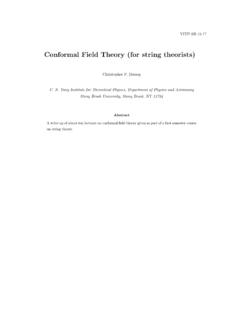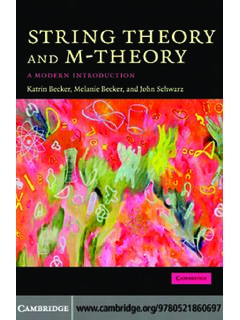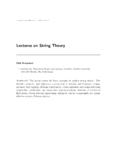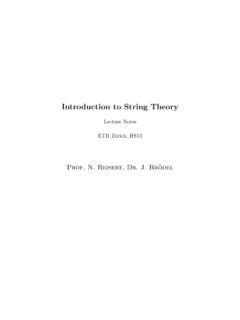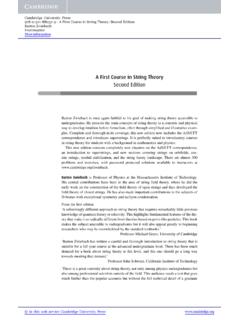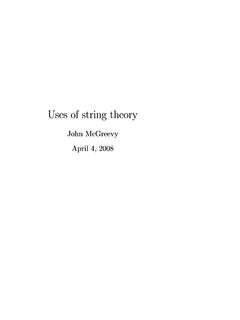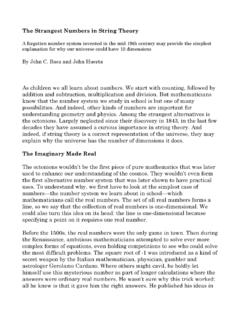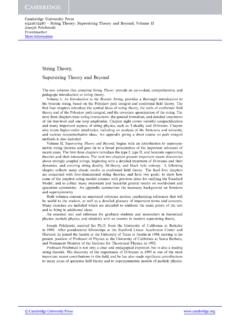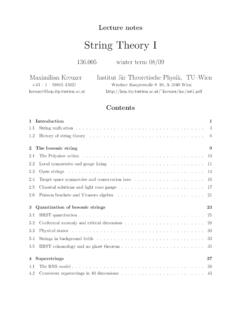Transcription of INTRODUCTION to STRING FIELD THEORY
1 INTRODUCTION toSTRING FIELD THEORYW arren SiegelUniversity of MarylandCollege Park, MarylandPresent address: State University of New York, Stony Known models (interacting) Outline62. General light Conformal Poincar Covariantized light cone20 Exercises233. General Gauge invariance IGL(1) OSp(1,1|2) From the light More dimensions46 Exercises514. General gauge OSp(1,1|2) IGL(1) Extra Gauge Fermions75 Exercises795. SuperBRST110 Exercises1186. Gauge Conformal Light cone125 Exercises1277. Light-cone quantum Supersymmetric137 Exercises1458. BRST quantum IGL(1) OSp(1,1|2) Lorentz gauge160 Exercises1709. External Loops190 Exercises19610.
2 Light-cone FIELD theory197 Exercises20311. BRST FIELD Closed Components207 Exercises21412. Gauge-invariant Midpoint interaction217 Exercises228 References230 Index241 PREFACEF irst, I d like to explain the title of this book. I always hated books whose titlesbegan INTRODUCTION In particular, when I was a grad student, books titled INTRODUCTION to Quantum FIELD THEORY were the most difficult and advanced text-books available, and I always feared what a quantum FIELD THEORY book which wasnot introductory would look like. There is now a standard reference on relativisticstring THEORY by Green, Schwarz, and Witten,Superstring THEORY [ ], which con-sists of two volumes, is over1,000 pages long, and yet admits to having some majoromissions.
3 Now that I see, from an author s point of view, how much effort is nec-essary to produce a non-introductory text, the words INTRODUCTION to take a moretranquilizing character. (I have worked onaone-volume, non-introductory text onanother topic, but that was in association with three coauthors.) Furthermore, thesewords leave me the option of omitting topics which I don t understand, or at leastbeing more heuristic in the areas which I haven t studied in detail rest of the title is STRING FIELD THEORY . This is the newest approachto STRING THEORY , although the older approaches are continuously developing newtwists and improvements. The main alternative approach is the quantum mechanical(/analog-model/path-integral/i nteracting- STRING -picture/Polyakov/confo rmal- FIELD - THEORY ) one, which necessarily treats a fixed number of fields, corresponding tohomogeneous equations in the FIELD THEORY .
4 (For example, there is no analog in themechanics approach of even the nonabeliangauge transformation of the FIELD THEORY ,which includes such fundamental concepts as general coordinate invariance.) It is alsoan S-matrix approach, and can thus calculate only quantities which are gauge-fixed(although limited background- FIELD techniques allow the calculation of 1-loop effectiveactions with only some coefficients gauge-dependent). In the old S-matrix approachto FIELD THEORY , the basic idea was to startwiththeS-matrix, and then analyticallycontinue to obtain quantities which are off-shell (and perhaps in more general gauges).However, in the long run, it turned out to be more practical to work directly withfield THEORY Lagrangians, even for semiclassical results such as spontaneous symmetrybreaking and instantons, which change the meaning of on-shell by redefining thevacuum to be a state which is not as obvious from looking at the unphysical-vacuumS-matrix.
5 Of course, S-matrix methods are always valuable for perturbation THEORY ,but even in perturbation THEORY it is far more convenient to start with the FIELD theoryin order to determine which vacuum to perturb about, which gauges to use, and whatpower-counting rules can be used to determine divergence structure without specificS-matrix calculations. (More details on this comparison are in the INTRODUCTION .)Unfortunately, STRING FIELD THEORY is in a rather primitive state right now, and noteven close to being as well understood as ordinary (particle) FIELD THEORY . Of course,this is exactly the reason why the present is the best time to do research in this area.(Anyone who can honestly say, I ll learn itwhen it s better understood, should markadateonhiscalendar for returning to graduate school.)
6 It is therefore simultaneouslythe best time for someone to read a book on the topic and the worst time for someoneto write one. I have tried to compensate forthisproblem somewhat by expanding onthe more introductory parts of the topic. Several of the early chapters are actuallyon the topic of general (particle/ STRING ) FIELD THEORY , but explained from a new pointof view resulting from insights gained from STRING FIELD THEORY . (A more standardcourse on quantum FIELD THEORY is assumed as a prerequisite.) This includes the useof a universal method for treating free fieldtheories,which allows the derivation ofasingle,simple, free, local, Poincar e-invariant,gauge-invariant action that can beapplied directly to any FIELD .
7 (Previously,only somespecial cases had been treated,and each in a different way.) As a result, even though the fact that I have tried tomake this book self-contained with regard tostring THEORY in general means that thereis significant overlap with other treatments, within this overlap the approaches aresometimes quite different, and perhaps in some ways complementary. (The treatmentsof ref. [ ] are also quite different, but for quite different reasons.)Exercises are given at the end of each chapter (except the INTRODUCTION ) to guidethe reader to examples which illustrate the ideas in the chapter, and to encouragehim to perform calculations which have been omitted to avoid making the length ofthis book workwas done at the University of Maryland, with partial support fromthe National Science Foundation.
8 It is partly based on courses I gave in the falls of1985 and 1986. I received valuable comments from Aleksandar Mikovi c, ChristianPreitschopf, Anton van de Ven, and Harold Mark Weiser. I especially thank BartonZwiebach, who collaborated with me on most of the work on which this book 16, 1988 Warren SiegelOriginally published 1988 by World Scientific Publishing Co Pte 9971-50-731-5, 9971-50-731-3 (pbk)July 11, 2001:liberated, corrected, bookmarks added (to pdf) Motivation11. MotivationThe experiments which gave us quantum THEORY and general relativity are nowquite old, but a satisfactory THEORY which is consistent with both of them has yetto be found. Although the importance of such a THEORY is undeniable, the urgencyof finding it may not be so obvious, since the quantum effects of gravity are notyetaccessible to experiment.
9 However, recent progress in the problem has indicatedthat the restrictions imposed by quantum mechanics on a FIELD THEORY of gravitationare so stringent as torequirethat it also be a unified THEORY of all interactions, andthus quantum gravity would lead to predictions for other interactions which can besubjected to present-day experiment. Such indications were given by supergravitytheories [ ], where finiteness was found atsome higher-order loops as a consequenceof supersymmetry, which requires the presence of matter fields whose quantum effectscancel the ultraviolet divergences of the graviton FIELD . Thus, quantum consistency ledto higher symmetry which in turn led to unification. However, even this symmetry wasfound insufficient to guarantee finiteness at allloops[ ] (unless perhaps the gravitonwere found to be a bound-state of a truly finite THEORY ).
10 Interest then returned totheories which had already presented the possibility of consistent quantum gravitytheories as a consequence of even larger (hidden) symmetries: theories of relativisticstrings [ ]. Strings thus offer a possibility of consistently describing all of , even if strings eventually turn out to disagree with nature, or to be toointractable to be useful for phenomenological applications, they are still the onlyconsistent toy models of quantum gravity (especially for the THEORY of the gravitonas a bound state), so their study will still beuseful for discovering new properties ofquantum fundamental difference between a particle and a STRING is that a particle is a 0-dimensional object in space, with a 1-dimensional world-line describing its trajectoryin spacetime, while a STRING is a (finite, open orclosed)
